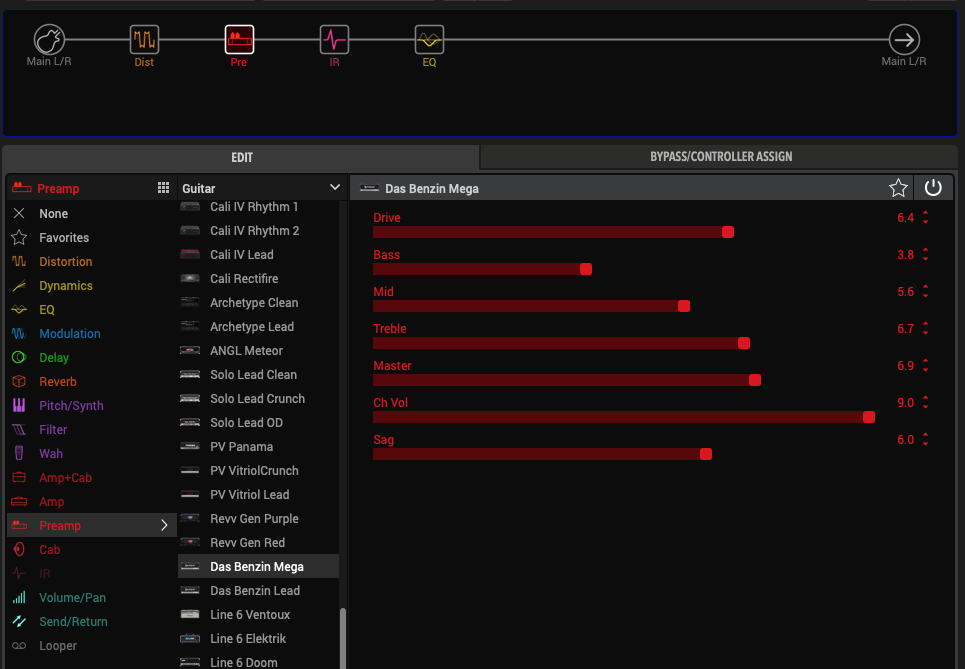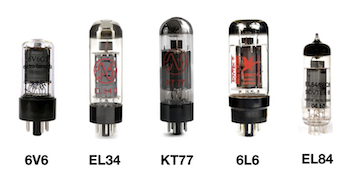- Created : January 25, 2023
- Updated : April 29, 2023
Introduction
During my recent tests of impulse response loaders (the Sonic cake IR and the TC Impulse from TC Electronic) I used different configurations with amps associated with a loadbox, preamps, distortion pedals… With real amps and a load box, there were no problem, the results were very interesting and very usable. With preamp pedals or distortion pedals the result tended to sound a bit flat and dull, and lacked a lot of punch… I was missing the touch provided by the tube power amplifier section to give punch and breadth and the tone lacked realism (these two IR loaders do not offer power amp simulations)…. TC’s approach around pedal-platform IRs gave me the idea to continue and move forward on tests that I had started two years ago around IRs incorporating the color provided by power amps – tube power amps-….
Previously….
In the blog post “Impulse Response part 4” I presented the use of IRs with pedals and introduced -for beginners- the role of the guitar power amplifier and the coloring of sounds provided by EL34, 6L6, KT88, … valves : you can check it here: https://overdriven.fr/overdriven/index.php/fr/2019/12/20/reponses-pulse-partie-4/.
In the following post (“part 5”), I experimented around IR captures of power amps tone, for users who do not have amp simulations and/or who would like to experiment with this approach: it can give interesting results, but it remains complicated to implement because you have to stack two loaders in series and the level configuration between the two loaders is a little bit tricky… in short, not really easy to use (you can read the IR part 5 post here : https://overdriven.fr/overdriven/index.php/2020/03/20/impulse-responses-part-5/).
So I resumed my tests on this subject and I worked on IRs directly incorporating the signature of power amps, with different amps in different configurations… Some English speakers will name these as “IRs with power-amps baked- in”….
Baked-in power amps
The idea was to start from conventional IRs – actually the most neutral possible in my case – and then to add some coloring and tone provided by the power section of a guitar amp: basically, trying to make the IR sound as if it’s being played through a 6L6, EL34, EL84, etc… amp. Ultimately, this is what IR loaders with power amp simulation offer….


For whom and what for ? First, for users of loaders who use pre-amps: for example pre-amp or distortion pedals, or Synergy type pre-amps, and who either do not have a loader with an embedded power-amp simulation (the TC Impulse, the Sonicake IR, the Flamma charger or the Mooer Cab X2 for example do not have one), or who are not satisfied with the results they obtain with the simulations they have… it can also interest those who would simply like to explore alternatives and access even more tonal possibilities…
Of course, in this approach, IRs lose their neutral character and….that is the goal…. : they are designed here to give a specific coloring and give breadth to the sound, adding the specific EQ shape provided by tube-amps and a part of their resonance. They can therefore be used directly with pre-amp pedals, pre-amps or even multi-effects units, but in this last case, preferably on multi-effects that offer a pre-amp block type and an optional power-amp simulation (if you are using a multi-effect that does not have this possibility, I do not recommend using this type of IRs because you are probably not going to obtain good results, with too much bass resonance or with a quite veiled tone….but you are free to experiment 🙂 )
Note: depending on your gear (pedals, overdrives, guitar pickups, preamp…), the tuning you play in, and the IRs you’re using, and the type of sound you’re looking for, you may NOT find these IRs to be very interesting… On the other hand you feel like your sound lacks breadth and depth, then give them a try…
How these IRs can be created ?
One can imagine using several approaches to capture this type of IRs :
- capture directly the IR using a guitar amp with 6L6, EL34, EL84 tubes,… adjusting the presence and resonance settings to provide a significant amount of color…
- mix / combine IR with a power amp type IR
- equalize the IR by adding resonance and simulating the frequency response of power amps, instead of or in addition to the above two approaches.
- …
Note: the overdriven.fr free collections captured with KT-88 and 6L6 amps provide some tube coloring but that was not the primary intent : these captures were actually made trying to minimize the color given by the valves. However, this approach could be used in this case by increasing the resonance and presence of the amps to get more color and a stronger tone shaping effect.
A demo pack
So I have been experimenting and I chose one of my favorite IRs of the moment, based on a G12-65 speaker captured with the class D amplifier, which I declined in 28 versions with different settings and levels of the power amps, with different amplifiers and tube types. I also carried out numerous tests with pre-amp type pedals: a Wampler Triple Wreck and a Revv G4 as well as two Synergy pre-amps: the Herbert and the VH4 (using an overdrive in front of these pedals or these pre -amps).
You will find the download link for this example pack at the end of the article and you will also find below the list of proposed IRs, all based on a single starting IR : a G12-65 speaker captured with an RE-20 microphone.
The original collection – without embedded power amps – can be downloaded here: https://overdriven.fr/overdriven/index.php/ir-german-112-celestion-g12-65-class-d-home-studio- edition-free-guitar-cab-impulse-responses-download/.
11 IRs are offered with 6L6 tubes : some of them are quite similar, with rather subtle differences, but you should clearly hear the differences when switching from 6L6s to EL34s, EL84s, 6V6s, or KT77 and KT88.
If you use pre-amp or distortion pedals or a Synergy type pre-amp connected to an IR loader, you can use these IRs directly. If your IR loader has a power amp simulator (Cab M, Radar, Engl Cab Loader,….): turn it off to avoid double coloring… Note: you can also use the signal from your amp through your effects loop’s FX Send, but make sure it’s connected to a load (ie a cab or a load box) if it’s a tube amplifier.
If you use a multi-effects like the Mooer GE 200, 250, 300 or the PreampX2, the amp blocks correspond in most cases to pre-amps, without the color from power tubes: load the IRs proposed here and leave the amp simulation power to OFF … (for more information on the Mooer MNRS system, you can check this review). The same technique can be used if you have a derivative device like Harley Benton or Flamma multi-effects.
For Helix users, you can use the pre-amp blocks directly with an IR block (do not use the standard amp blocks as they are supposed to provide a “full” signal). Use the IR2048 block on the Helix for best results.

Same for the Hotone Ampero II: pre-amp blocks are available, so same approach as described for the Helix: use these blocks to leverage these IRs and do not add the power amp simulation block of the Ampero II.
For multi-effects that do not offer this option of preamp block only (like the Hotone Ampero 1st generation for example), I do not recommend using these IRs: you will probably get a sound that is too bassy and too colorful , unless you drastically review your bass and treble levels…. Same thing for the Kemper: the amplifier block corresponds in most cases to a preamplifier + a power amplifier signature…. But you are free to try 🙂
In any case, you will have to adjust your tone settings to be able to take advantage of these IRs: bass, mids, treble, gain, presence…. And you can of course refine the result by using an equalizer before or after the IR block and/or using a low cut.
Demo pack IR list
The pack contains the following IRs (they have a hi-cut filter but the low-end of the spectrum is not processed: use a low cut or an EQ if you get too much resonance with your gear):
- OD-E112-G12-65-DYN-US-8-6L6-1.wav
- OD-E112-G12-65-DYN-US-8-6L6-10.wav
- OD-E112-G12-65-DYN-US-8-6L6-11.wav
- OD-E112-G12-65-DYN-US-8-6L6-2.wav
- OD-E112-G12-65-DYN-US-8-6L6-3.wav
- OD-E112-G12-65-DYN-US-8-6L6-4.wav
- OD-E112-G12-65-DYN-US-8-6L6-5.wav
- OD-E112-G12-65-DYN-US-8-6L6-6.wav
- OD-E112-G12-65-DYN-US-8-6L6-7.wav
- OD-E112-G12-65-DYN-US-8-6L6-8.wav
- OD-E112-G12-65-DYN-US-8-6L6-9.wav
- OD-E112-G12-65-DYN-US-8-6V6.wav
- OD-E112-G12-65-DYN-US-8-EL34-1.wav
- OD-E112-G12-65-DYN-US-8-EL34-2.wav
- OD-E112-G12-65-DYN-US-8-EL34-3.wav
- OD-E112-G12-65-DYN-US-8-EL34-4.wav
- OD-E112-G12-65-DYN-US-8-EL34-5.wav
- OD-E112-G12-65-DYN-US-8-EL84-1.wav
- OD-E112-G12-65-DYN-US-8-EL84-2.wav
- OD-E112-G12-65-DYN-US-8-KT77-1.wav
- OD-E112-G12-65-DYN-US-8-KT77-2.wav
- OD-E112-G12-65-DYN-US-8-KT77-3.wav
- OD-E112-G12-65-DYN-US-8-KT77-4.wav
- OD-E112-G12-65-DYN-US-8-KT88-1.wav
- OD-E112-G12-65-DYN-US-8-KT88-2.wav
- OD-E112-G12-65-DYN-US-8-KT88-3.wav
- OD-E112-G12-65-DYN-US-8-KT88-4.wav
- OD-E112-G12-65-DYN-US-8-KT88-5.wav
Samples
Will be added soon.
Download link
You can access this demo pack here : https://overdriven.fr/overdriven/index.php/download/german-112-g12-65-ssp1-classd-pwramps-demo/
Conclusion
I created this little pack for experimental purposes, primarily for users of pre-amp and distortion pedals who do not have an IR loader with power amp simulation: don’t hesitate to post comments to share your results and experience with these IRs, and what equipment you use (pedal, preamplifier,.…). If you know creators of IRs of the same type, please post the references in the comments.
A future article will explore another technique that can be used with IRs, which is somewhat similar to this one but even more specialized: the technique of tone-matching, or the incorporation this time of the complete signature of an amplifier into an IR.
Change log
- Created January 25, 2023
- Updated January 26, 2023 : typos and minor edits
- Updated February 12, 2023 : typos, edits and pictures
- Update Avril 29, 2023 : typos and edits

2023-01-26 at 17:07
Using a pre-amp or power amp in the signal flow adds a bit of extra eq to the signal. What you won’t get is the compression by the saturation process because IR is a lineair technique (won’t overdrive, won’t even generate aliasing… fun factor: you can perfectly use a 22 kHz IR when you adding a low pass to it).
There’s also a lot of debate weather or not the speaker is lineair or not. Personally I love that IRs are lineair.
Thanks for your work. Hopefully I will be able to check out your files soon.
2023-01-26 at 21:18
Thanks for the comment Marco ! You are right, the dynamic behavior of power amps is not captured with these IRs, but they get an additional “shape” that mimics their frequency response combined to the response of the starting IR. The KT88-3 is one of my favorites here, be sure to check it !
David
2023-02-10 at 15:35
This technique doesn’t work, because the “tube sound” is all about dynamic saturation, a non-linear process that CANNOT be captured or recreated via convolution, unless we are going into very advanced approaches like Acoustica Audio’s Nebula stuff, which is a separate approach from ordinary convolution.
The experiment is still valuable, since it proofs what is missing when one tries to cover non-linear processes with ordinary convolution tech.
Thanks for your interesting content!
2023-09-06 at 17:15
I would like to take this opportunity to say a big thank you for your great work! You are good at explaining such things! Although I’ve been making conventional music for a long time, I’m just starting to get involved with the subject and I’m very interested in your research!
2023-09-06 at 21:07
Thank you for your kind comment !
David
2023-12-07 at 07:49
I’m looking forward to for your big IRs package with tube amps baked- in.
It includes ( KT66\KT77\KT88\EL34\6L6\EL84\6V6\…WOW…
and 1×12\2×12\4×12\4×10 ….WOW…
That’s exhilarating and interesting!
I believe that most people perfectly willing to pay for it.